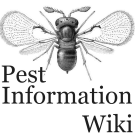Publications for:
pest = Matsucoccus feytaudi
crop = Pine (Pinus)
found 9 publications:2016
Adaptive management of invasive pests in natural protected areas: the case of Matsucoccus feytaudi in Central ItalyBulletin of Entomological Research (2016) 106 (1), 9-18
publishers website - pestinfo wiki
2015
Reproductive requirements and life cycle of Iberorhyzobius rondensis (Coleoptera: Coccinellidae), potential biological control agent of Matsucoccus feytaudi (Hemiptera: Matsucoccidae)Environmental Entomology (2015) 44 (3), 846-854
publishers website - pestinfo wiki
2013
Monitoring of Matsucoccus feytaudi (Hemiptera: Matsucoccidae) and its natural enemies in Spain using sticky tapes and pheromone trapsEuropean Journal of Entomology (2013) 110 (2), 301-310
publishers website - pestinfo wiki
A GIS-based cost distance approach to analyse the spread of Matsucoccus feytaudi in Tuscany, Italy (Coccoidea Matsucoccidae)
REDIA (2013) 96, 9-16
pestinfo wiki
2006
A common mode of attraction of larvae and adults of insect predators to the sex pheromone of their prey (Hemiptera: Matsucoccidae)Bulletin of Entomological Research (2006) 96 (2), 179-185
publishers website - pestinfo wiki
Tree species diversity reduces the invasibility of maritime pine stands by the bast scale, Matsucoccus feytaudi (Homoptera: Margarodidae)
Canadian Journal of Forest Research - Revue Canadienne de Recherche Forestière (2006) 36 (2), 314-323
publishers website - pestinfo wiki
2005
Xylophagous insects of maritime pine stands attacked by Matsucoccus feytaudi Duc. (Homoptera Margarodidae) in Liguria and Tuscany (Italy)REDIA (2005) 88 (App.), 1-7
pestinfo wiki
2004
Effect of trap design, trap size and pheromone dose on male capture of two pine bast scales species (Hemiptera: Matsucoccidae): implications for monitoring and mass-trappingAgricultural and Forest Entomology (2004) 6 (3), 233-239
publishers website - pestinfo wiki
2002
The use of sex pheromones of Matsucoccus species (Homoptera Margarodidae) for monitoring and mass trapping of M. feytaudi Ducasse and for kairomonal attraction of its natural enemies in ItalyREDIA (2002) 85, 155-171
pestinfo wiki
